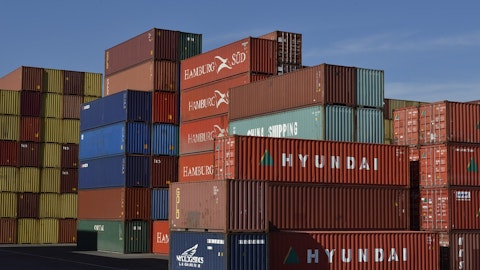And as a part of a result of that is basically the customers are not necessarily choosing to discount product they’re choosing to sell at a better price. Now for that, that’s good. You see in the numbers of many of the organizations we work in. They’re actually furring well. But obviously, in our business, it’s more a volume aspect that travels through our warehouses. So that’s probably the most significant point that you’re seeing in our quarter four numbers. And it’s compounded a little bit by traditionally, quarter four is always a very important quarter for our customers. It is this quarter. Quarter four, it’s going to be very important. We’re all focused on it. But again, because of the volume typically, historically, we might be implementing several smaller overflow warehouses, just to court with those extra volumes that happened in the last quarter.
This time around, we’re not seeing any evidence of that. And I guess the last thing I mentioned earlier, I think there’s definitely signs that the consumer themselves, they’re putting off starting the holiday season shopping. They’re putting it off to later in the — closer to the end of the year basically in the hope that maybe some of that discounting will occur. So, that’s the kind of backdrop that we’re seeing. Maybe I can ask Baris just to comment on the fine detail on the numbers for you, Amit, because it’s really important.
Amit Mehrotra: Before if I could just ask a question. So I’m going to loop out because I wanted to ask about growth for next year because it seems like there’s — it’s a cyclical issue, which worries me less than a churn issue. So that’s fine. But as we think about you go out of business for next year, I think it all tallies up to like 7% to 8% growth, assuming underlying volume and churn is kind of flat. So, can we get back to organic growth in like high single digits next year, just given the new business that you won and the dynamic that we’re kind of at the bottom right now? Is that a fair assumption?
Malcolm Wilson: I mean new business, as I mentioned earlier, it’s been incredibly strong. If you just look at this year, $840 million of new business signed this year $525 of that is landing in 2024, another $200 million of that $800 million is going to be landing in ’25 and just in the last quarter, $180 million, the very nice stat on that is broadly 50% of that is coming from first-time outsourcing. So all of that’s rolling forward. You’re absolutely right in your observation. I guess when we think about next year, we’re right now, literally, this last week, we’ve had lots of the management teams present in meetings. We’re starting budgeting cycle. And that budgeting cycle will take us through to the end of the year. In that, we’re collecting all of the information from customers all of their forecast for next year, the plans for expansion, the plans for changing products, everything goes into that.
It’s a true bottom-up process that then allows us to bring into place our guide for the year ahead. It’s a bit soon right now for us to be thinking about that, really, the business, we’re just all focused on this last couple of months, so critical for our customers.
Amit Mehrotra: Yes. That’s fair. And then one sneaky one, if I could. I know I’m over my allotment, but I wanted to talk to Adrian for around the automation. So Adrian, everything you said was really compelling and there are a lot of buzzwords in there in terms of automation and AI. I think the problem that we’ve had on the analytical side is kind of converting that into what it actually means for the model. And so as you take on this new position of Chief Automation Officer, what are the KPIs for you that kind of allow you to move because there’s a lot of anecdotal evidence of automation, but the problem I’ve had is that the Company still has a huge amount of direct labor costs, and I’m trying to balance those two. So as you think about this new role, like every quarter, every month, whatever it is, how are you judging the success from a KPI perspective that we can maybe follow to?
Adrian Stoch: Amit, thanks for the question. So I’m going to answer it in two different categories. The first is around operational or tactical metrics, and the second is more strategic and financial. So from an operational perspective, we’re going to look at the amount of adaptive tech that we’re redeploying as a success measure because, of course, the more we’re able to establish those best practices and best case scenarios and then roll them out to other sites, the more we get the leverage of that from a global perspective. So, the extent of adaptive tech expansion. Secondly, of course, we’ll measure very tactically the execution of plans in terms of what each of the regions will be targeting with respect to implementations.
And so from a tactical perspective, but I think what’s more relevant for this audience is around the more strategic and financial indicators, which will be focused on the revenue derived from automation and the margin that we get from the automated operations. Those will be the two primary financial metrics that we’ll be talking about.
Operator: Our next questions come from the line of Jason Seidl with TD Cowen. Please proceed with your question.
Jason Seidl: I wanted to touch a little bit about your outlook for ’24. I think before you mentioned that you saw maybe a turnaround coming in late one half. How should we assume that runs throughout your geographies since you mentioned green shoots in Europe, should that be hitting Europe first and then maybe North America in the second half of the year? How are you looking at it?
Adrian Stoch: Let me walk you through some of the elements of Q4 because it impacts 2024 as well. We’re seeing right now 2% to 4% growth for 2023, which is the middle range implies a flat growth for Q4. We delivered 3% organic growth in Q3, but heading into Q4, we’re seeing more volume headwinds. And when you put in components, the first is you see seasonal one-off impact from reduced pop-up activities, these are Christmas-related warehouses we have been operating. It’s about 1% to 2% impact, slower ramp-up of new facilities. They are not immune from the current volume environment, about 1% to 2% impact. And lastly, number three is reduced volume from our existing facilities, which is about 5% impact. All of this is roughly making 8% to 9% headwind is balanced with our business wins and pricing pass-throughs, inflation pass-throughs that we have in our business that comes to our flattish growth in Q4.


